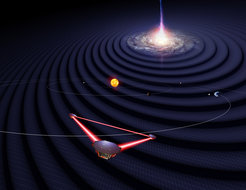LISA reaches a crucial milestone
The future gravitational-wave observatory in space completes a rigorous review
LISA, the Laser Interferometer Space Antenna, has reached an important milestone: it has passed the comprehensive “Mission Formulation Review” (MFR) and now enters the next phase of development. The review team, consisting of experts from ESA, NASA, the scientific community and industry, identified no showstoppers and confirmed that LISA has successfully reached a maturity sufficient to proceed to the next stage of development.
The MFR confirms the feasibility of the LISA mission and identifies a clear path of technology developments needed to reach the next major milestone: the mission adoption. The MFR is a checkpoint to ensure that the technology and planning for LISA is sufficiently mature; this is a prerequisite for mission development to continue. In an ESA mission lifetime cycle, the MFR is the formal end of Phase A (mission feasibility). LISA now enters Phase B1 that is focused on the preliminary definition of the mission.

“LISA is well underway. We are now entering phase B1 during which we do more detailed design work to establish the complete set of mission requirements and the verifications approach”, says Prof Karsten Danzmann, Lead of the LISA Consortium.
Martin Gehler, LISA Study Manager at the European Space Agency, adds: “The review was a major success for all stakeholders and the fruit of vigorous work on Consortium, NASA, and ESA side over the last years.”
AEI Hannover is leading in the development of LISA and in the LISA consortium. Karsten Danzmann, director at AEI Hannover, is the LISA consortium lead. In collaboration with the National Space Insitute at Denmark's Technical University (DTU), AEI Hannover is developing and building the phase meter, one of the mission’s central hardware components. In addition, the institute is leading numerous large LISA subprojects and work packages in optical meteorology and interferometry. The institute has the world's largest laboratories for the LISA mission interferometry.
Background information
LISA: Through observations of gravitational waves, LISA will offer an unprecedented and unique view of the Universe, quite different from any other space telescope and any ground-based gravitational-wave detector. LISA will deliver pioneering scientific results enabling insights not available through electromagnetic observations. Combining LISA observations with those of other ground- and space-based facilities will also allow scientists to make enormous advances in multi-messenger astronomy.
The LISA instrument will consist of three spacecraft in a triangular configuration with 2.5 million kilometer arms, moving in an Earth-like orbit around the Sun. Gravitational waves from sources throughout the Universe will produce slight oscillations in the arm lengths (smaller than the diameter of an atom). LISA will capture these motions and thus measure the gravitational waves by using laser links to monitor the displacements of test masses free-falling inside the spacecraft. The LISA satellites are being built by ESA, ESA member nations, and NASA.
LISA´s hardware got its first and very successful test in space with the LISA Pathfinder (LPF) mission, led by ESA with NASA participation. This included a thorough test of crucial components of LISA´s technology. LPF demonstrated that it’s possible to place and maintain test masses in free-fall to an astonishing level of precision, and that the exquisite metrology needed for LISA meets the requirements.
LISA will observe gravitational waves in a lower frequency band than those detectable by LIGO and Virgo, allowing us to observe much larger systems at earlier times in the Universe’s history.
The LISA Consortium is a large international collaboration that combines the resources and expertise from scientists in many countries all over the world. Together with ESA as the lead agency and NASA as an international partner, the LISA Consortium is working to bring the LISA mission to fruition.












